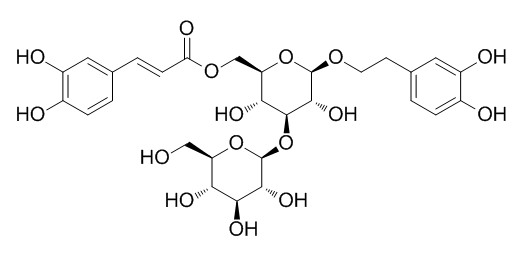Plantainoside D
Plantainoside D shows potent antioxidative effects as those of ascorbic acid, it shows angiotensin-converting enzyme (ACE) inhibitory inhibitory activity in vitro with the IC(50) value of 2.17 mM, it also shows inhibitory activity against PKCalpha with the IC50 value (in microM) of 14.8. Plantainoside D protects adriamycin-induced apoptosis in H9c2 cardiac muscle cells via the inhibition of ROS generation and NF-kappaB activation.
Inquire / Order:
manager@chemfaces.com
Technical Inquiries:
service@chemfaces.com
Tel:
+86-27-84237783
Fax:
+86-27-84254680
Address:
1 Building, No. 83, CheCheng Rd., Wuhan Economic and Technological Development Zone, Wuhan, Hubei 430056, PRC
Providing storage is as stated on the product vial and the vial is kept tightly sealed, the product can be stored for up to
24 months(2-8C).
Wherever possible, you should prepare and use solutions on the same day. However, if you need to make up stock solutions in advance, we recommend that you store the solution as aliquots in tightly sealed vials at -20C. Generally, these will be useable for up to two weeks. Before use, and prior to opening the vial we recommend that you allow your product to equilibrate to room temperature for at least 1 hour.
Need more advice on solubility, usage and handling? Please email to: service@chemfaces.com
The packaging of the product may have turned upside down during transportation, resulting in the natural compounds adhering to the neck or cap of the vial. take the vial out of its packaging and gently shake to let the compounds fall to the bottom of the vial. for liquid products, centrifuge at 200-500 RPM to gather the liquid at the bottom of the vial. try to avoid loss or contamination during handling.
J Nat Med.2020, 74(1):65-75
J Pharm Biomed Anal.2022, 207:114398.
Food Res Int.2022, 157:111207.
Food and Bioprocess Technology2017, 10(6):1074-1092
Int Immunopharmacol.2021, 101(Pt A):108181.
Molecules.2020, 25(20):4851.
Chem Biol Interact.2023, 378:110487.
Life Sci.2019, 216:259-270
Natural Product Sciences2024, 30(4):254-261.
Food Quality and Safety2018, 2:213-219
Related and Featured Products
Phytother Res. 2010 Jul;24(7):1088-94.
Bioguided isolation of angiotensin-converting enzyme inhibitors from the seeds of Plantago asiatica L.[Pubmed:
19998322]
METHODS AND RESULTS:
Ethanolic extract of the seeds of Plantago asiatica L. showed significant inhibitory activity of angiotensin-converting enzyme (ACE) determined by monitoring the transformation from a substrate hippuryl-histidyl-leucine (HHL) to the product hippuric acid (HA) in vitro using an UPLC-MS method. The bioguided fractionation of the extract resulted in the isolation of four ACE inhibitory active phenylpropanoid glycosides acteoside, isoacteoside, Plantainoside D, and plantamajoside with IC(50) values of 2.69 mM, 2.46 mM, 2.17 mM, and 2.47 mM, respectively. Their structures were elucidated through the analysis of NMR, UV, IR and MS data.
CONCLUSIONS:
Our study is the first demonstration that Plantago asiatica L. and its major constituents have ACE inhibitory activity in vitro. It is assumed that the identified compounds contribute to the angiotensin-converting enzyme-inhibitory activity of the extract.
Life Sci. 2007 Jan 2;80(4):314-23.
Plantainoside D protects adriamycin-induced apoptosis in H9c2 cardiac muscle cells via the inhibition of ROS generation and NF-kappaB activation.[Pubmed:
17034819 ]
Plantainoside D (PD), was isolated from the leaves of Picrorhiza scrophulariiflora (Scrophulariaceae). The anti-oxidative activity of PD was evaluated based on scavenging effects on hydroxyl radicals and superoxide anion radicals. Adriamycin (ADR) is a potent anti-tumor drug known to cause severe cardiotoxicity. Although ADR generates free radicals, the role of free radicals in the development of cardiac toxicity has not been understood.
This study was undertaken to investigate the protective effect of PD against ADR-induced apoptosis.
METHODS AND RESULTS:
In vitro, ADR caused dose-dependent toxicity in H9c2 cardiac muscle cells. Pre-treatment of the cardiac muscle cells with PD significantly reduced ADR-induced apoptosis of cardiac muscle cells. PD inhibited the ROS produced by ADR in the cardiac muscle cells. As well, PD increased GSH(glutathione), compared with ADR. In response to ADR, NF-kappaB was activated in H9c2 cells. However the treatment of PD reduced the activation of NF-kappaB. We also observed that the NF-kappaB inhibitor, PDTC, inhibited the cytotoxic effect on ADR-induced apoptosis in cardiac muscle cells. In parallel, IkappaBalpha-dominant negative plasmid-overexpression abrogated ADR-induced apoptosis in H9c2 cardiac muscle cells.
CONCLUSIONS:
In conclusion, these results suggest that Plantaionoside D can inhibit ADR-induced apoptosis in H9C2 cardiac muscle cells via inhibition of ROS generation and NF-kappaB activation. The pure compound PD can be a potential candidate agent which protects cardiotoxicity in ADR-exposed patients.
J Nat Prod. 1998 Nov;61(11):1410-2.
Phenylethanoid glycosides from Digitalis purpurea and Penstemon linarioides with PKCalpha-inhibitory activity.[Pubmed:
9834166 ]
METHODS AND RESULTS:
In a continuation of our search for potential tumor inhibitors from plants, it was found that the CH2Cl2-MeOH (1:1) extracts from Digitalis purpurea and Penstemon linarioides both showed PKCalpha-inhibitory bioactivity. Bioassay-directed fractionation of the extract from D. purpurea yielded the new, weakly active phenylethanoid glycoside 2-(3-hydroxy-4-methoxy-phenyl)-ethyl-O-(alpha-L-rhamnosyl)-(1-->3) -O- (alpha-L-rhamnosyl)-(1-->6)-4-O-E-feruloyl-beta-D-glucopy ran oside (1) together with the four known compounds calceolarioside A (2), calceolarioside B (3), forsythiaside (4), and Plantainoside D (5). The extract from P. linarioides yielded the three known glycosides leucosceptoside A (6), acteoside (7), and poliumoside (8), together with the iridoid plantarenaloside (9).
CONCLUSIONS:
All of the isolated compounds, except compound 9, showed inhibitory activity against PKCalpha with IC50 values (in microM) of 125 (1), 0.6 (2), 4.6 (3), 1.9 (4), 14.8 (5), 19.0 (6), 9.3 (7), and 24.4 (8).
Chem Pharm Bull (Tokyo). 2004 May;52(5):615-7.
Antioxidative phenylethanoid and phenolic glycosides from Picrorhiza scrophulariiflora.[Pubmed:
15133218]
METHODS AND RESULTS:
One new phenylenthanoid glycoside, scroside D (2), was isolated from the roots of Picrorhiza scrophulariiflora (Scrophulariaceae), together with nine known phenylethanoid and phenolic glycosides: 2-(3,4-dihydroxyphenyl)-ethyl-O-beta-D-glucopyranoside (1), 2-(3-hydroxy-4-methoxyphenyl)-ethyl-O-beta-D-glucopyranosyl (1-->3)-beta-D-glucopyranoside (3), scroside B (4), hemiphroside A (5), Plantainoside D (6), scroside A (7), androsin (8), piceoside (9), and 6-O-feruloyl-beta-D-glucopyranoside (10). The structures of these compounds were elucidated using spectroscopic methods. The antioxidative activities of these isolated compounds were evaluated based on their scavenging effects on hydroxyl radicals and superoxide anion radicals, respectively.
CONCLUSIONS:
Compounds 1, 2, and 6 showed potent antioxidative effects as those of ascorbic acid and the structure-activity relationship is discussed.



